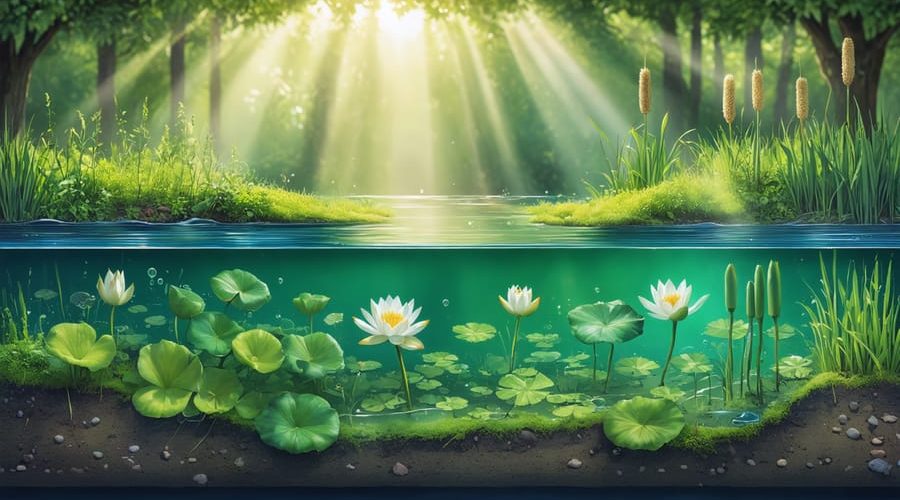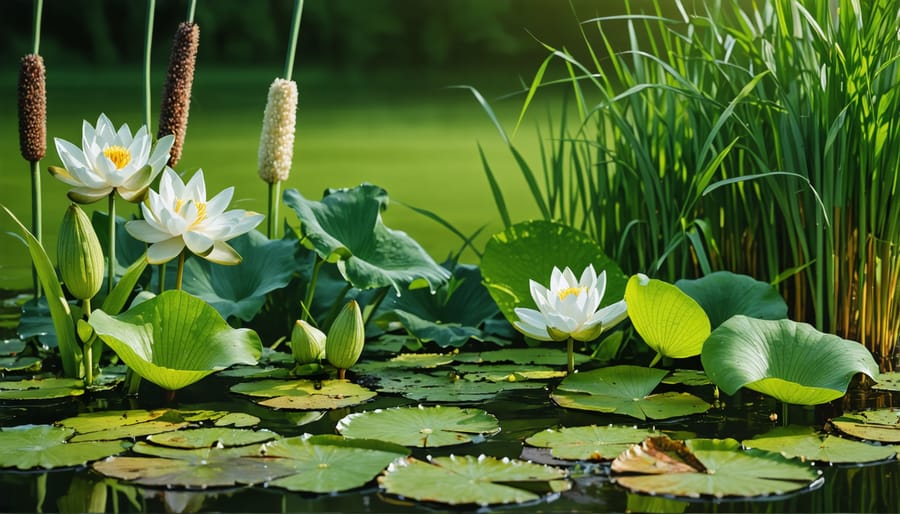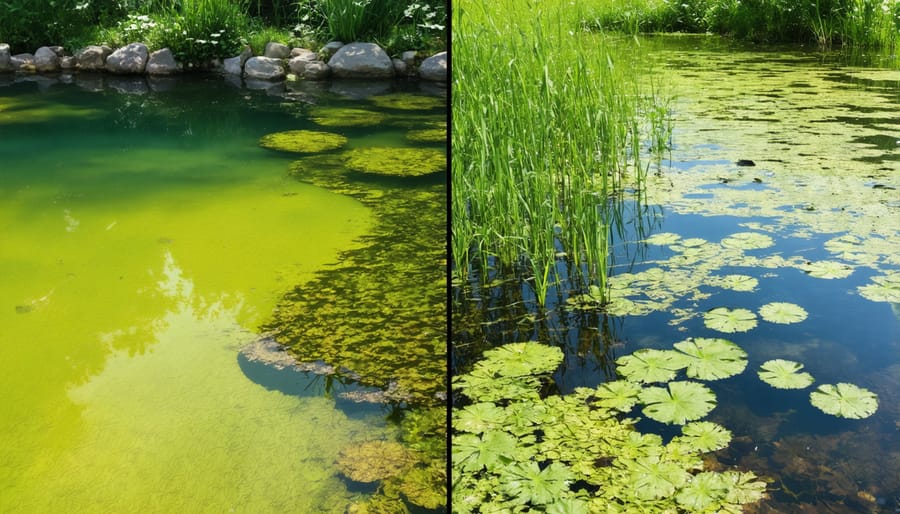
How Your Pond’s Plants Create Nature’s Perfect Balance
In the vibrant world of aquatic ecosystems, net primary productivity (NPP) serves as the fundamental engine that powers all life beneath the surface. This crucial measure represents the amount of energy captured and stored by aquatic plants, algae, and other photosynthetic organisms after accounting for their own respiratory needs. From serene backyard ponds to vast ocean expanses, NPP determines an ecosystem’s ability to support diverse life forms and maintain ecological balance. Understanding this relationship is essential for both ecosystem management and environmental conservation, as it directly influences water quality, oxygen levels, and the abundance of aquatic life. Through the interplay of sunlight, nutrients, and temperature, aquatic NPP creates the foundation upon which entire food webs are built, making it a critical indicator of ecosystem health and sustainability. Whether you’re a pond enthusiast or environmental scientist, grasping the dynamics of aquatic NPP opens the door to better water management practices and more successful aquatic habitats.
Understanding Net Primary Productivity in Your Pond
The Solar-Powered Pond Factory
Imagine your pond as a tiny solar-powered factory, where sunlight is the ultimate energy source driving all life within it. Just like solar panels convert sunlight into electricity, aquatic plants transform sunlight into energy through photosynthesis. This process is the foundation of net primary productivity in your pond ecosystem.
When sunlight hits the water, aquatic plants and algae capture this energy using chlorophyll, the green pigment in their cells. They combine this solar power with carbon dioxide and water to create glucose – their food source – while releasing oxygen as a bonus for other pond inhabitants.
The amount of sunlight reaching your pond directly impacts how much energy these underwater plants can produce. Deeper waters receive less light, which is why you’ll often see more plant growth near the surface. That’s also why floating plants like water lilies and duckweed are such efficient producers – they have direct access to sunlight without any water filtering it out.

Meet Your Pond’s Primary Producers
In your pond’s underwater world, several key players work tirelessly to produce energy and oxygen. At the foundation, you’ll find microscopic phytoplankton, tiny algae that float freely in the water. These mini powerhouses might be invisible to the naked eye, but they’re essential for your pond’s health. Alongside them, larger algae forms like string algae and blanket weed contribute to the ecosystem, though you’ll want to keep these in check.
Rooted aquatic plants are your pond’s star performers. Water lilies, with their floating leaves, capture sunlight while providing beautiful blooms. Submerged plants like hornwort and anacharis work beneath the surface, oxygenating the water. Along the edges, marginal plants such as cattails and rushes not only add visual interest but also help filter nutrients and provide shelter for wildlife.
For the best results, aim for a mix of these different plant types. This diversity ensures your pond maintains steady productivity throughout the seasons and creates a balanced ecosystem that’s both beautiful and sustainable.
Key Factors Affecting Your Pond’s Productivity

Light Penetration and Water Clarity
In aquatic ecosystems, the clarity of water plays a crucial role in determining how much sunlight reaches underwater plants. Think of water as nature’s sunglasses – the clearer it is, the more light passes through to nourish aquatic life. Understanding the relationship between light and nutrients for pond life is essential for maintaining a healthy ecosystem.
When water is murky or contains lots of suspended particles, it blocks sunlight from reaching deeper levels. This reduced light penetration limits the depth at which plants can photosynthesize effectively. Just like your garden plants need sunshine to grow, underwater plants require adequate light to produce energy and contribute to the ecosystem’s productivity.
The depth at which light can no longer support photosynthesis is called the compensation point. Above this point, plants produce more energy than they consume, contributing to net primary productivity. Below it, they struggle to grow. That’s why you’ll often see more plant life near the water’s surface or in clearer waters, where light can reach further down.
Temperature and Seasonal Changes
Temperature plays a crucial role in the seasonal cycles of pond productivity. Just like your garden changes with the seasons, your pond’s productivity ebbs and flows with temperature variations. During warmer months, when the sun’s rays penetrate deeper into the water, aquatic plants and algae become more active, increasing overall productivity. This is why you might notice more vigorous plant growth and clearer water in summer.
In contrast, colder temperatures slow down these processes. Winter brings reduced sunlight and lower temperatures, causing many aquatic plants to go dormant. This natural cycle helps maintain balance in your pond ecosystem throughout the year. Spring and fall serve as transition periods, where productivity gradually shifts between these extremes.
For the best pond health, work with these natural cycles rather than against them. Expect slower growth in winter and plan maintenance accordingly, while being prepared for increased activity during warmer months.
Nutrient Availability
Just like your garden needs good soil to grow healthy plants, aquatic ecosystems rely heavily on nutrients to support their primary productivity. The main nutrients that fuel aquatic plant growth are nitrogen and phosphorus, which act like natural fertilizers in the water. When these nutrients are available in the right amounts, they support healthy algae and plant growth, which in turn produces more oxygen and food for fish and other aquatic life.
Think of nutrients as nature’s recipe ingredients – too little, and plants can’t grow properly; too much, and you might end up with problematic algae blooms. In most pond ecosystems, nutrients come from decomposing organic matter, fish waste, and runoff from surrounding areas. The availability of these nutrients often follows seasonal patterns, with higher levels during spring and fall when leaves and other organic matter break down.
For the best pond health, it’s important to maintain a balanced nutrient level through regular maintenance and careful feeding practices.
Maintaining Healthy Productivity Levels

Plant Selection and Placement
When selecting plants for your aquatic ecosystem, consider different zones of water depth, as each supports distinct plant types. Start with submerged plants like hornwort or anacharis, which oxygenate the water and provide essential shelter for aquatic life. These should occupy about 50-60% of your pond’s bottom.
Next, add floating plants such as water lilies or lotus to cover roughly 30-40% of the water surface. These not only add visual appeal but also provide shade that helps control algae growth and maintains water temperature. Remember to space them adequately, allowing room for growth and surface movement.
For the pond margins, incorporate emergent plants like cattails or iris at varying heights. These plants help filter nutrients and create natural transitions between water and land. Position them in shallow shelves or baskets, ensuring they’re planted at their preferred depth.
Consider your local climate when selecting species, and opt for native plants when possible. They’re typically better adapted to your region’s conditions and support local wildlife. Place taller plants on the north side to prevent excessive shading, and shorter varieties on the south side where they’ll receive optimal sunlight.
Group plants with similar water and nutrient needs together for easier maintenance. This thoughtful arrangement ensures each plant contributes effectively to your pond’s overall productivity while creating a balanced, visually appealing ecosystem.
Water Quality Management
Maintaining optimal water quality is crucial if you want to build a balanced pond ecosystem with healthy productivity levels. Start by regularly testing your water’s pH, which should typically stay between 6.5 and 8.5. Use a reliable testing kit to check these levels weekly, especially during warmer months when algae growth can spike.
Keep an eye on dissolved oxygen levels by ensuring proper water movement through fountains or waterfalls. If you notice fish gasping at the surface, that’s a clear sign you need more aeration. Adding aquatic plants can help naturally maintain oxygen levels while absorbing excess nutrients.
Monitor water clarity using the simple hand test – if you can see your hand clearly when submerged up to your elbow, your water quality is generally good. Remove fallen leaves and debris promptly, as decomposing organic matter can throw off your water chemistry and reduce productivity.
Consider installing a proper filtration system that includes both mechanical and biological filtration. This helps remove waste while maintaining beneficial bacteria populations that break down harmful compounds. During summer, partial water changes of about 10-15% every few weeks can help prevent nutrient buildup and maintain stable conditions for optimal productivity.
Remember to avoid overfeeding fish, as excess food leads to water quality issues. A good rule of thumb is to feed only what your fish can consume in about 5 minutes.
Signs of Healthy Productivity in Your Pond
A thriving pond displays several telltale signs that indicate healthy primary productivity levels. Look for clear, vibrant water with a slight green tint – this suggests the perfect balance of beneficial algae. You’ll notice plenty of underwater plants growing steadily, with bright green leaves reaching toward the surface. These plants are your pond’s natural productivity powerhouses!
Watch for active fish behavior, particularly during daylight hours. Happy fish darting around and feeding near the surface often indicate good oxygen levels, which is directly linked to healthy aquatic ecosystem balance. Small insects and beneficial microorganisms should be visible near the water’s surface, especially in the morning hours.
Your pond’s edges should host thriving marginal plants with strong root systems. Keep an eye out for natural color variations in your aquatic plants – deep greens, reds, and purples suggest they’re receiving adequate nutrients. A gentle bubbling sound from your water features indicates good circulation, which helps distribute nutrients throughout the system.
Seasonal changes are normal, but a productive pond maintains its vitality year-round. In spring and summer, expect abundant plant growth and active wildlife. During cooler months, while growth slows, healthy plants should maintain their color and structure. Remember, these signs work together to paint a picture of your pond’s overall health.
Maintaining a healthy level of productivity in your pond is crucial for a thriving aquatic ecosystem. By monitoring key factors like sunlight exposure, nutrient levels, and plant density, you can create an environment where life flourishes. Remember to regularly check water clarity, observe plant growth patterns, and maintain a balance between different types of aquatic vegetation. Make seasonal adjustments as needed, and don’t hesitate to seek advice from local experts if you notice any concerning changes. With proper care and attention, your pond can become a vibrant ecosystem that provides beauty and enjoyment for years to come. The rewards of maintaining optimal productivity levels are well worth the effort – from crystal-clear water to happy fish and stunning water lilies. Keep learning, stay observant, and enjoy watching your aquatic paradise thrive!
